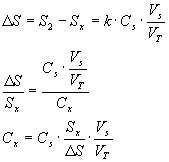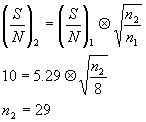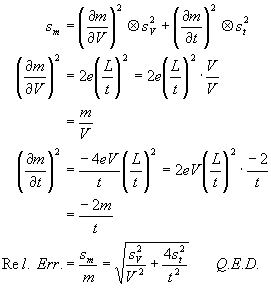Chemistry 422 Exam I Name:
September 25, 1998
KEY
Instructions: Read the whole exam before starting to work on individual problems; work those that you find the easiest first. Budget you time!
1 We want to determine the concentration of an unknown, Cx, by the method of standard addition. You measure the signal, Sx, from the unknown solution. Then you add a small amount, Vs, of a standard solution having a concentration of Cs and measure the signal again (V2).
a) Show that if Vs.<<Vx then the concentration of unknown is
where VT = the total volume
Solution
: Determine general equation for each solution; apply approximation and simplify.| 1. General equations: |  |
| 2. When Vs.<<Vx, then Vx » VT |  |
| 3. Simplify |  |
b) The signal intensity was 38.44 for a solution of unknown concentration. When 0.05000 mL of a solution having a concentration of 0.2000 M was added to 25.00 mL of the unknown, the signal increased to 48.15. What was the concentration of the unknown solution?
Solution
: Substitute into given equation and solve.
2 DC conversion:
a) Draw a circuit diagram of a full-wave rectifier and explain the principles of its operation;
Solution
: See notesA total voltage of 5.11 V was measured across two parallel resistors that had resistances of 15.00 W and 32.15 W . What is the current going through each resistor?b)
Solution
: The voltage across each resistor is the same; simply use Ohm’s law twice. Ans.: 0.159 A and 0.341 A3 Digital output using D/A converters:
a) The input voltage on a 4-bit D/A converter was 5.33 V what would the output voltage be for a digital output of 1011?
Solution
:b) What would be the relative error in the output of the D/A signal for a 12-bit D/A converter? Assume all of the error is equal to the smallest output voltage.
Solution
:4 Operational amplifiers:
a) Draw an operational amplifier circuit which allows you to perform the calculation:
. Be sure to include specific values for you resistors.
Solution
: One possible configuration would be to use an inverting unity gain operational amplifier to make the output of that amplifier - V1 and then to send it through a resistor on a summing circuit for the - V1 and V2. The gain should be 6 and 8 respectively.b) What are the properties of ideal operational amplifiers? Draw the equivalent circuit for one.
Solution
: See notes and book.5 Noise:
The following data were obtained for a voltage measurement on a noisy system: 1.37, 1.84, 1.35, 1.47, 1.10, 1.73, 1.54, 1.08
a) Assuming only random noise, what is the signal-to-noise ratio?
Solution
: The signal to noise ratio will equal the mean divided by the standard deviation. This gives a S/N of 5.29 for this set of data.b) How many measurements would have to be averaged to increase the S/N to 10?
Solution
: The signal to noise ratio increases with the square root of the number of measurements. One could write:
6 Error:
In a time of flight mass spectrometer, the mass is determined by the flight time according to the equation:
a) Derive an equation that will allow you to calculate the relative error in the determination of the mass. Assume that e (the charge on an electron) and L (the length of the flight tube) are constants.
Solution
: use the normal error equation, recognizing that m(V,t); take the derivative of the equation with respect to each variable and then simplify.
b) Determine the relative error in the calculation of mass of benzene, C6H6 if t = 42.7± 0.5 m s and V = 5.00± 0.08 V.
Solution
: Substitute into above.